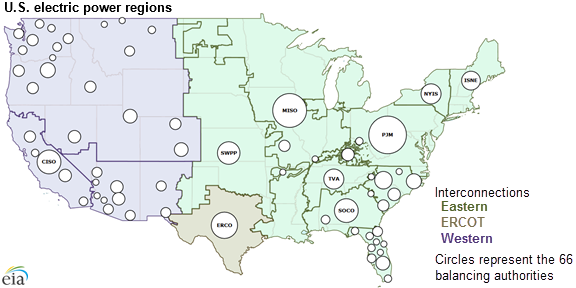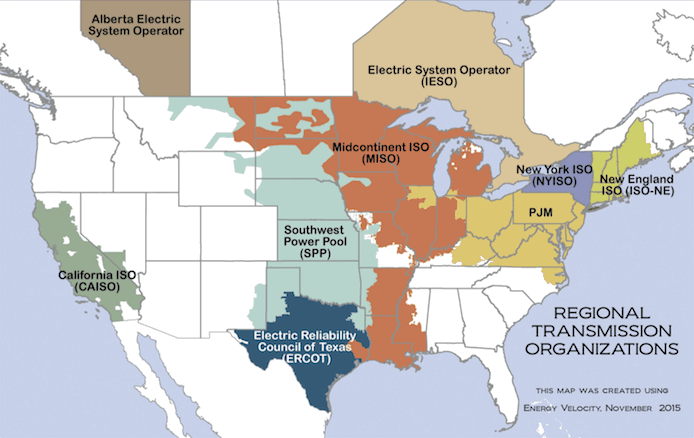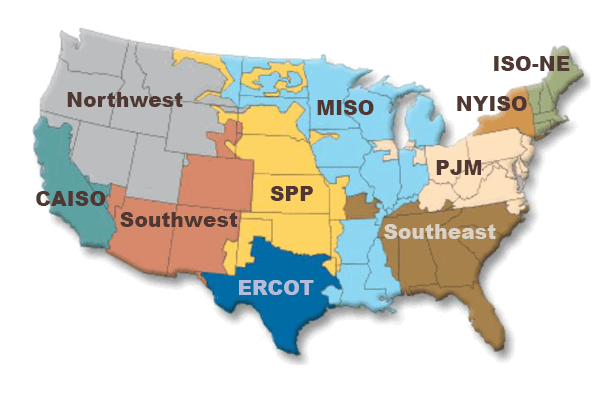The Big Picture – 3 Interconnections, 66 Balancing Authorities
The physical electrical system consists of 3 "Interconnections" that are largely independent with minimal power exchange (colored regions in figure). Operationally, there are 66 U.S. "Balancing Authorities" that each operate a portion of the grid, balancing supply and demand at all times, and assuring Federal reliability standards are met. Most Balancing Authorities are individual utilities, while most of the total power flow is managed by 7 larger regional entities (ISOs or RTOs) that perform the balancing function. ISOs/RTOs also oversee organized wholesale electricity markets, whereas most individual utilities are vertically-integrated monopolies that control all electricity generation, transmission, and distribution within their territory.
- Eastern Interconnection (36 balancing authorities, including 5 in Canada)
- Western Interconnection (37 balancing authorities, including 3 in Canada and Mexico)
- ERCOT (most of Texas - 1 balancing authority - within a single state, so not regulated by the FERC)
RTOs (or ISOs) – 7 Regional Transmission Pools with Wholesale Electricity Markets
Each ISO or RTO (they are very similar) is an independent body that operates the high-voltage Transmission grid of all Transmission owners within its region. An RTO also: assures non-discriminatory open access to transmission; forecasts, schedules and dispatches generation to meet demand; manages interconnection of new generation; administers the region's competitive wholesale electricity markets; monitors the fairness and neutrality of markets for all participants; and provides reliability planning for the bulk electricity system. An ISO/RTO does not own any of the transmission or generation assets it manages. Each ISO has its own FERC-approved governance structure. Some RTOs also have retail-level competition and consumer choice of electricity providers.
Non-RTO Regions – Operated by Many Individual Regulated Monopoly Utilities
The non-RTO regions — Southwest (orange), Northwest (gray), and Southeast (brown) — are operated by many individual vertically-integrated utilities (or Federal systems). These utilities have been granted monopoly status over "ratepayers" in their territory, and they are regulated by state Public Utility Commissions (PUCs or PSCs). A "cost-of-service" utility revenue model guarantees a rate-of-return on all investments, which incentivizes capital-intensive, inefficient solutions lacking in innovation or consumer choice. Although these utilities don't participate in wholesale power markets, they must still comply with open Transmission access. Power exchanges between utilities are mostly bilateral agreements or Power Purchase Agreements (PPAs). They retain control over their transmission system, which leads to preferential treatment for their own generation over more affordable and/or cleaner and/or local generation from competitive suppliers and marketers.
Digging Deeper: The Origin and Characteristics of ISOs & RTOs [also see wikipedia]
In the mid-90s, many regions pushed for wholesale competition as a way to create equal access to the transmission system and provide consumers with a choice of energy suppliers. ISOs were established by FERC Orders 888 & 889 in 1996 to provide open and fair access to transmission, and promote competitive wholesale electricity markets. Order 888 also allowed utilities to recover stranded costs associated with providing open access to transmission during the transition from regulated monopolies to open competition. Order 888 stated that the main purpose of an ISO is to "operate the transmission systems of public utilities in a manner that is independent of any business interest in sales or purchases of electric power by those utilities."
FERC Order 888 defined how independent power producers (IPPs) and power marketers would be allowed fair access to transmission systems, and specified the unbundling of a utility's generation and transmission and distribution. Most ISOs are set up as nonprofit corporations.
Order 889 established an Open Access Same-time Information System (OASIS) to provide potential transmission users with information on available transmission capacity, prices, and other information. Prior to Orders 888/889, vertically-integrated entities controlled energy provision in their territories and there was no consumer choice (still true in Colorado and elsewhere).
FERC Order 2000 in 1999 defined and promoted the (voluntary) formation of RTOs to administer the transmission grid on a regional basis. An RTO is defined by 4 minimum characteristics and 8 minimum functions (listed here), including: independence from market participants, full control of transmission facilities and coordination of security, tariff administration and design, transmission congestion management, market monitoring, transmission planning and expansion, and administering OASIS. RTOs are independent, membership-based, non-profit organizations that ensure reliability and optimize supply and demand bids for wholesale electric power. Members of RTOs can include: independent generators, transmission companies and load-serving entities, vertically-integrated utilities, and other entities such as power marketers and energy traders.
Participation in an RTO is not mandatory in order to comply with Order 888 (an ISO is fine but is less rigorously defined, and ISOs can apply to FERC and become RTOs). Both ISOs and RTOs are associated with "deregulation", retail electricity choice, and management of a transmission grid they don't own over a wide geographic region. An ISO is usually within a single state, and an RTO usually manages a multi-state region. An ISO either does not meet the minimum standards to be called an RTO, or has not applied to the FERC for RTO status.
A group of Colorado utilities called the Mountain West Transmission Group (MWTG) has a proposal to join the Southwest Power Pool (SPP). The proposal is currently under consideration at the Colorado Public Utilities Commission (PUC). For more about the status of the MWTG initiative, see our wholesale electricity markets webpage, and our PUC Comment concerning alternatives to SPP.
Additional Resources:
- Good summary from CAISO: "Why ISOs/RTOs are good for America".
- Excellent history of deregulation of wholesale and retail electricity markets in ISO-NE: website or PDF.
- Overview of wholesale markets, RTO/ISOs, and competitive markets (somewhat dated): website or PDF.
- This brief summary of utility structures points to state-by-state summaries of utility structure and PUC makeup, plus interesting energy data (monthly retail electricity cost; net generation by fuel source). Here are some of the pages for Colorado: Regulatory Commission; Largest Utilities; Energy Data. It's a commercial product, so much more information is locked, but what's available is useful.


